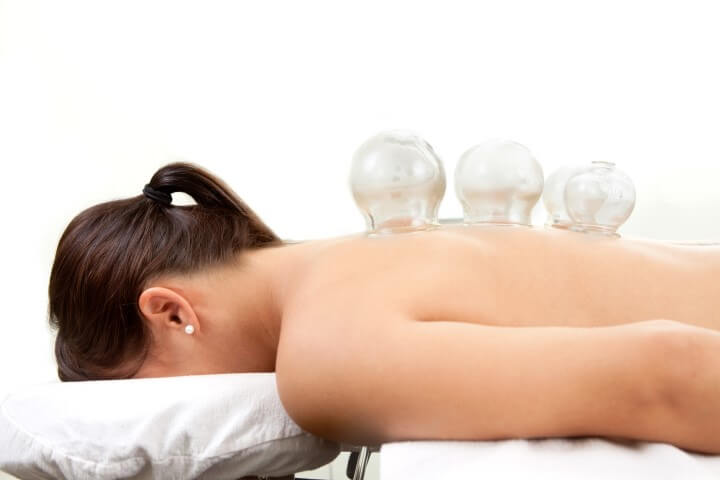Fire cupping or simply cupping is a form of traditional medicine found in many cultures worldwide. It involves placing cups containing reduced air pressure (suction) on the skin.
It is known in local languages as badkesh, bahnkes, bekam, buhang, bentusa, kuyukaku, gak hoi, hijama, and many other names.
History
Although there is reason to believe the practice dates from as early as 3000 B.C., the earliest record of cupping is in Ebers Papyrus, one of the oldest medical textbooks in the world. It describes in 1,550 B.C. Egyptians used cupping.
Archaeologists have found evidence in China of cupping dating back to 1,000 B.C. In ancient Greece, Hippocrates (c. 400 B.C.) used cupping for internal disease and structural problems.
This method in multiple forms spread into medicine in Asian and European civilizations.
Cupping in Europe and the Middle East grew from humoral medicine, a system of health ancient Greeks used to restore balance through the four “humors” in the body: blood, phlegm, yellow bile and black bile.
This system was pervasive in European and Middle-East cultures at the time. To apply a cup, its oxygen has to be extinguished, enabling the cup to suck the skin and draw blood to that area.
To let blood, punctures were made before applying the cup, after removing the cup or in the following sequence to increase bloodletting, the removal of excess blood to restore health: suck, puncture, suck.
Humoral medicine had a brief revival in European medicine in the 18th and 19th centuries, and cupping was used widely in this practice.
In traditional Chinese medicine (TCM) cupping is a method of applying acupressure by creating a vacuum on the patient’s skin.
The therapy is used to dispel stagnation—stagnant blood and lymph, thereby improving qi flow—to treat respiratory diseases such as the common cold, pneumonia and bronchitis.
Cupping also is used on back, neck, shoulder and other musculoskeletal conditions. Its advocates say it has other applications, too.
Many people in the late 20th century have discovered this long standing therapy, cupping, an alternative therapy, and are finding its efficacy long ago stands today.
Effects
According to the American Cancer Society, “available scientific evidence does not support cupping as a cure for cancer or any other disease”. It can leave temporary unsightly marks on the skin and there is also a small risk of burns.
Persons who claim this therapy to be beneficial report that it produces feeling of relaxation and invigoration.
It is possible that whatever relief is obtained from this procedure derives from the same principles that are employed in shiatsu massage, where instead of the outward sucking of the cups, strong inward pressure is directed at the muscles of the dorsal ribcage and abdomen.
Methods
The cupping procedure commonly involves creating a small area of low air pressure next to the skin. However, there is variety in the tools used, the method of creating the low pressure, and the procedures followed during the treatment.
The cups themselves can be various shapes including balls or bells, and may range in size from 1 to 3 inches (25mm – 75mm) across the opening.
Plastic and glass are the most common materials used today, replacing the horn, pottery, bronze and bamboo cups used in earlier times.
The low air pressure required may be created by heating the cup or the air inside it with an open flame or a bath in hot scented oils, then placing it against the skin.
As the air inside the cup cools, it contracts and draws the skin slightly inside. More recently, vacuum can be created with a mechanical suction pump acting through a valve located at the top of the cup.
Rubber cups are also available that squeeze the air out and adapt to uneven or bony surfaces.
In practice, cups are normally used only on softer tissue that can form a good seal with the edge of the cup. They may be used singly or in large number to cover a larger area.
They may be used by themselves or placed over an acupuncture needle. Skin may be lubricated, allowing the cup to move across the skin slowly.
The skin may be lanced before placing the cup so that the vacuum draws fluids, primarily blood, into the cup as part of the treatment.Depending on the specific treatment, skin marking is common after the cups are removed.
This may be a simple red ring that disappears quickly, but more aggressive treatments can result in deeper bruising. In general, the longer a cup is left on, the more of a circular mark is created.
Usually treatments are not painful, but treatment should be discontinued if the person receiving it experiences more than minor discomfort.
Wet Cupping
In this alternative form of bloodletting, also called blood cupping, a small scratch or incision is made with a lancet prior to the cupping, and the pressure difference extracts blood from the skin.
Islamic traditional medicine uses this technique – called in Arabic hijamah or hijama – with a number of hadith supporting its recommendation and use by the Islamic prophet Muhammad.
The hijama method cautions against over cupping, cupping in the lying down position and sleeping or resting following any cupping procedure, claiming that the one real danger of cupping is the potential risk of blood clotting following a procedure.
Patients should take a brisk thirty minute walk following any cupping treatment. When properly performed, using tiny incisions and not leaving the cups on longer than necessary, cupping leaves no marks or scarring.






